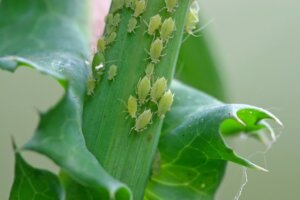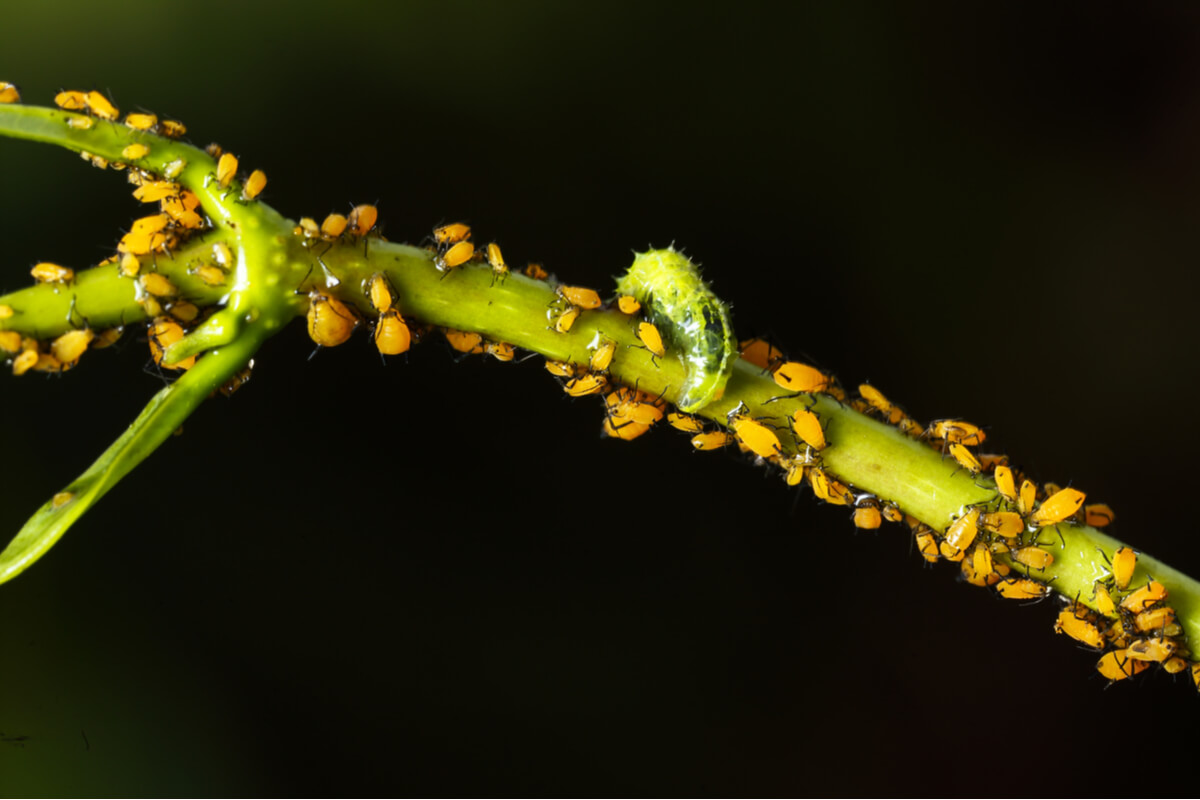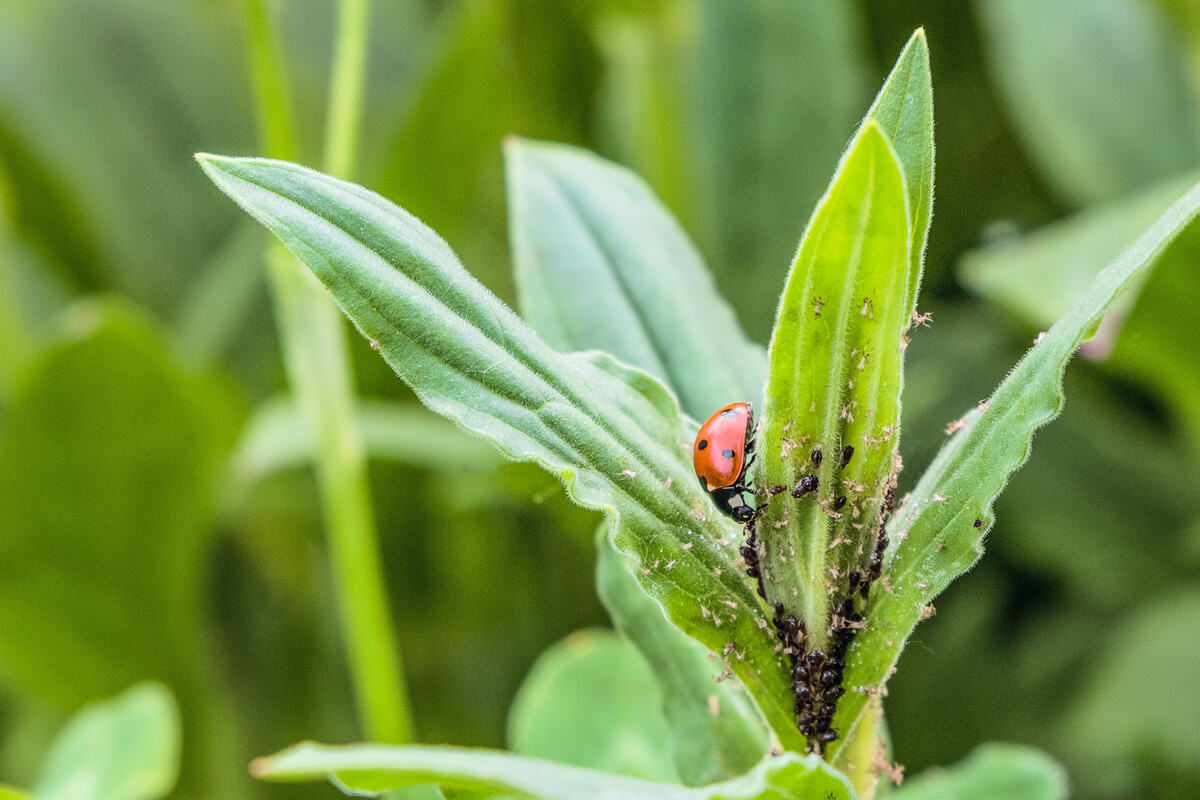How to Get Rid of Aphids on Plants


Written and verified by the biologist Samuel Sanchez
Learning how to get rid of aphids from plants is a Herculean task for the world’s farmers. Their high reproductive rate and the rapid spread of these insects means that insecticide is of little use, as a single untreated nook and cranny can cause the population to explode again rapidly. Getting rid of aphids takes equal parts of ingenuity and expertise.
Aphids are biologically very interesting, but we need to recognize that they’re a serious problem in the agricultural industry. If you’d like to know how to get rid of aphids without damaging the ecosystem, you’re in the right place. Read on.
What are aphids?
The term “aphid” doesn’t refer to a single species, but to a taxon of sap-sucking insects belonging to the superfamily Aphidoidea. About 5000 species have been identified within this group, of which 400 are considered to be pests of human-produced crops.
Aphids can be found anywhere in the world, although they’re much more common in hot and temperate areas. They’re sparsely distributed in the tropics, but an impressive diversity can be found in areas with a Mediterranean or mild climate. They reach their peak activity in the spring season.
Most aphids have a soft body with a brownish, red, green, or semi-transparent color. On their head, they carry their sensory organs (antennae and compound eyes) and their specialized sucking apparatus, which is known as the stylet.
These invertebrates are a serious problem at an agricultural level for several reasons. Among them, we highlight the following:
- Their reproduction is extremely fast. Aphids alternate between sexual and asexual reproductive cycles, which allows the population to expand in a very short time.
- Aphids feed passively on plant sap. If the parasitic load of the plant is very high, it may be unable to nourish all its tissues and it’ll end up rotting.
- They favor the spread of viruses. Aphids are viral vectors and by jumping from plant to plant they can infect an entire crop with a pathogen very quickly.
- They favor the growth of molds in damaged areas.
- They reach the crops without any effort. Winged aphids are passively transported by the wind, rising up to 600 meters above the ground effortlessly.
In short, aphids weaken the plant by sucking its sap, which favors the infestation of secondary pathogens in the crop. Their effects can be disastrous if populations aren’t controlled in the early stages.

How to get rid of aphids from plants
Now that we know a bit more about these insects, we’re ready to show you how to get rid of aphids from plants. We’ll show you the most effective measures around, so keep reading.
1. Larvae of syrphids
Biological controllers are usually the most effective when it comes to treating a pest. What better than a living species to kill another living species? The syrphids are a family of nectar-libbing Diptera that in their larval stage wipe out aphids.
It’s estimated that one syrphid larva can feed on up to 1000 aphids before metamorphosing into an adult, so the effectiveness of this method is self-explanatory. Of course, you should find out what species you’re going to acquire to control the aphids, and whether this treatment is legal in your country, because you may unknowingly be introducing a potentially invasive in your crops.
2. Ladybug larvae
The premise is the same as in the previous case: use a biological agent that respects the environment to kill a pest naturally. The larvae of certain ladybirds (family Coccinellidae) feed on 80% of aphids, although if these are scarce they can resort to ingesting pollen or other invertebrates. They’re excellent bio-controllers of this type of pests.
3. Pressurized water
Although it may sound crude, applying pressurized water on plants with a hose every 3-4 days in the early stages of infestation can be very useful. Aphids aren’t firmly attached to the plant surface, and so they’ll shoot into the air with the jet of water and die on impact with the soil. This isn’t a foolproof remedy, but it is effective when aphids are few in number.
4. Vinegar and water
We’re now starting with the more “homemade” methods to eliminate aphids from plants. While we don’t distrust their effectiveness, it is necessary to make it clear that not all reports are equally flattering with some of these procedures. Without a doubt, the most effective method in all cases will be the application of biological controllers.
If you want to try vinegar, just dilute 10 milliliters of vinegar in 90 milliliters of water (1/10 dilution) and spray the mixture on the most affected areas of the plant once a day. This will acidify the pH of the aphid’s environment, making it feel less comfortable, and it will either die or leave the plant.
5. Potassium soap
As its name suggests, potassium soap is a product with potassium as an essential component that has become well-known in agriculture for its pesticidal properties. Experts say that it’s biodegradable, but it must be prepared very carefully to ensure that an excess of chemicals does not end up fixing in the soil.
If you’ve bought potassium soap to get rid of aphids from plants, follow the steps below:
- Prepare the soap solution in water and dilute it to 1%. This means that you only need to add 1 milliliter of the compound for every 99 milliliters of water.
- Mix the product well in a spray bottle and shake it every time you’re going to use it.
- Cover the entire plant with the diluted product, especially the leaves and stems that contain a greater load of aphids.
- Try to apply the product when the sun isn’t shining, otherwise you could end up burning the plants.
- Apply the mixture for 15 days in a row in periods of 3-4 months.
Many aphids are affected by this mixture, but others (such as Myzus persicae) are somewhat more resistant. Also, keep in mind that potassium soap also kills ladybugs and their larvae, so you can’t use it in conjunction with other control methods.

So, in conclusion, we’ve presented 5 methods to get rid of aphids on plants, but they’re not the only ones by any means. Before implementing any of them, seek professional advice and find out whether it’s legal or illegal in your area, as you don’t want to create a new invasive pest or kill the natural species in the ecosystem.
Learning how to get rid of aphids from plants is a Herculean task for the world’s farmers. Their high reproductive rate and the rapid spread of these insects means that insecticide is of little use, as a single untreated nook and cranny can cause the population to explode again rapidly. Getting rid of aphids takes equal parts of ingenuity and expertise.
Aphids are biologically very interesting, but we need to recognize that they’re a serious problem in the agricultural industry. If you’d like to know how to get rid of aphids without damaging the ecosystem, you’re in the right place. Read on.
What are aphids?
The term “aphid” doesn’t refer to a single species, but to a taxon of sap-sucking insects belonging to the superfamily Aphidoidea. About 5000 species have been identified within this group, of which 400 are considered to be pests of human-produced crops.
Aphids can be found anywhere in the world, although they’re much more common in hot and temperate areas. They’re sparsely distributed in the tropics, but an impressive diversity can be found in areas with a Mediterranean or mild climate. They reach their peak activity in the spring season.
Most aphids have a soft body with a brownish, red, green, or semi-transparent color. On their head, they carry their sensory organs (antennae and compound eyes) and their specialized sucking apparatus, which is known as the stylet.
These invertebrates are a serious problem at an agricultural level for several reasons. Among them, we highlight the following:
- Their reproduction is extremely fast. Aphids alternate between sexual and asexual reproductive cycles, which allows the population to expand in a very short time.
- Aphids feed passively on plant sap. If the parasitic load of the plant is very high, it may be unable to nourish all its tissues and it’ll end up rotting.
- They favor the spread of viruses. Aphids are viral vectors and by jumping from plant to plant they can infect an entire crop with a pathogen very quickly.
- They favor the growth of molds in damaged areas.
- They reach the crops without any effort. Winged aphids are passively transported by the wind, rising up to 600 meters above the ground effortlessly.
In short, aphids weaken the plant by sucking its sap, which favors the infestation of secondary pathogens in the crop. Their effects can be disastrous if populations aren’t controlled in the early stages.

How to get rid of aphids from plants
Now that we know a bit more about these insects, we’re ready to show you how to get rid of aphids from plants. We’ll show you the most effective measures around, so keep reading.
1. Larvae of syrphids
Biological controllers are usually the most effective when it comes to treating a pest. What better than a living species to kill another living species? The syrphids are a family of nectar-libbing Diptera that in their larval stage wipe out aphids.
It’s estimated that one syrphid larva can feed on up to 1000 aphids before metamorphosing into an adult, so the effectiveness of this method is self-explanatory. Of course, you should find out what species you’re going to acquire to control the aphids, and whether this treatment is legal in your country, because you may unknowingly be introducing a potentially invasive in your crops.
2. Ladybug larvae
The premise is the same as in the previous case: use a biological agent that respects the environment to kill a pest naturally. The larvae of certain ladybirds (family Coccinellidae) feed on 80% of aphids, although if these are scarce they can resort to ingesting pollen or other invertebrates. They’re excellent bio-controllers of this type of pests.
3. Pressurized water
Although it may sound crude, applying pressurized water on plants with a hose every 3-4 days in the early stages of infestation can be very useful. Aphids aren’t firmly attached to the plant surface, and so they’ll shoot into the air with the jet of water and die on impact with the soil. This isn’t a foolproof remedy, but it is effective when aphids are few in number.
4. Vinegar and water
We’re now starting with the more “homemade” methods to eliminate aphids from plants. While we don’t distrust their effectiveness, it is necessary to make it clear that not all reports are equally flattering with some of these procedures. Without a doubt, the most effective method in all cases will be the application of biological controllers.
If you want to try vinegar, just dilute 10 milliliters of vinegar in 90 milliliters of water (1/10 dilution) and spray the mixture on the most affected areas of the plant once a day. This will acidify the pH of the aphid’s environment, making it feel less comfortable, and it will either die or leave the plant.
5. Potassium soap
As its name suggests, potassium soap is a product with potassium as an essential component that has become well-known in agriculture for its pesticidal properties. Experts say that it’s biodegradable, but it must be prepared very carefully to ensure that an excess of chemicals does not end up fixing in the soil.
If you’ve bought potassium soap to get rid of aphids from plants, follow the steps below:
- Prepare the soap solution in water and dilute it to 1%. This means that you only need to add 1 milliliter of the compound for every 99 milliliters of water.
- Mix the product well in a spray bottle and shake it every time you’re going to use it.
- Cover the entire plant with the diluted product, especially the leaves and stems that contain a greater load of aphids.
- Try to apply the product when the sun isn’t shining, otherwise you could end up burning the plants.
- Apply the mixture for 15 days in a row in periods of 3-4 months.
Many aphids are affected by this mixture, but others (such as Myzus persicae) are somewhat more resistant. Also, keep in mind that potassium soap also kills ladybugs and their larvae, so you can’t use it in conjunction with other control methods.

So, in conclusion, we’ve presented 5 methods to get rid of aphids on plants, but they’re not the only ones by any means. Before implementing any of them, seek professional advice and find out whether it’s legal or illegal in your area, as you don’t want to create a new invasive pest or kill the natural species in the ecosystem.
All cited sources were thoroughly reviewed by our team to ensure their quality, reliability, currency, and validity. The bibliography of this article was considered reliable and of academic or scientific accuracy.
- Aparatos bucales y regímenes alimentarios de los insectos, PDF. Recogido a 4 de octubre en http://agro.unc.edu.ar/~zoologia/ARCHIVOS/APARATOS%20BUCALES.pdf
- Organismos de control biológico en acción, Críalos tú mismo. Recogido a 4 de octubre en http://www.ciudadciencia.es/wp-content/uploads/2015/02/Material-taller-s%C3%ADrfidos.pdf
- Los enemigos naturales de los pulgones, Serida. Recogido a 4 de octubre en http://www.serida.org/publicacionesdetalle.php?id=4811
This text is provided for informational purposes only and does not replace consultation with a professional. If in doubt, consult your specialist.








